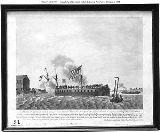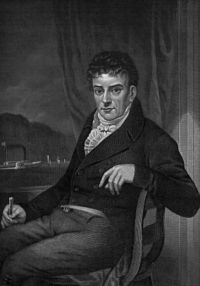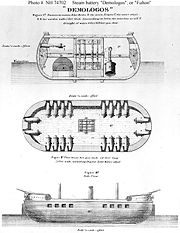
Demologos
Encyclopedia
Demologos was the first warship
Warship
A warship is a ship that is built and primarily intended for combat. Warships are usually built in a completely different way from merchant ships. As well as being armed, warships are designed to withstand damage and are usually faster and more maneuvrable than merchant ships...
to be propelled by a steam engine
Steam engine
A steam engine is a heat engine that performs mechanical work using steam as its working fluid.Steam engines are external combustion engines, where the working fluid is separate from the combustion products. Non-combustion heat sources such as solar power, nuclear power or geothermal energy may be...
. She was a wooden floating battery
Floating battery
A floating battery is a kind of armed watercraft, often improvised or experimental, which carries a heavy armament but has few other qualities as a warship.An early appearance was during the Great Siege of Gibraltar....
built to defend New York Harbor
New York Harbor
New York Harbor refers to the waterways of the estuary near the mouth of the Hudson River that empty into New York Bay. It is one of the largest natural harbors in the world. Although the U.S. Board of Geographic Names does not use the term, New York Harbor has important historical, governmental,...
from the Royal Navy
Royal Navy
The Royal Navy is the naval warfare service branch of the British Armed Forces. Founded in the 16th century, it is the oldest service branch and is known as the Senior Service...
during the War of 1812
War of 1812
The War of 1812 was a military conflict fought between the forces of the United States of America and those of the British Empire. The Americans declared war in 1812 for several reasons, including trade restrictions because of Britain's ongoing war with France, impressment of American merchant...
. The vessel was designed to a unique pattern by Robert Fulton
Robert Fulton
Robert Fulton was an American engineer and inventor who is widely credited with developing the first commercially successful steamboat...
, and was renamed Fulton after his death. Because of the prompt end of the war, Demologos never saw action, and no other ship like her was built.
History

United States Congress
The United States Congress is the bicameral legislature of the federal government of the United States, consisting of the Senate and the House of Representatives. The Congress meets in the United States Capitol in Washington, D.C....
authorized the construction of a steam warship to be designed by Robert Fulton, a pioneer of commercial steamers in North America. The construction of the ship began on 20 June 1814, at the civilian yard of Adam and Noah Brown, and the ship was launched on 29 October. After sea trials she was delivered to the United States Navy in June 1816. The ship was never formally named; Fulton christened it Demologos or Demologus, though following his death in February 1815, the ship was named Fulton.
By the time she was completed, the war for which Demologos had been built had ended. She saw only one day of active service, when she carried President James Monroe
James Monroe
James Monroe was the fifth President of the United States . Monroe was the last president who was a Founding Father of the United States, and the last president from the Virginia dynasty and the Republican Generation...
on a tour of New York Harbor. A two-masted lateen
Lateen
A lateen or latin-rig is a triangular sail set on a long yard mounted at an angle on the mast, and running in a fore-and-aft direction....
rig was added by the orders of her first commander, Captain David Porter
David Porter (naval officer)
David Porter was an officer in the United States Navy in a rank of commodore and later the commander-in-chief of the Mexican Navy.-Life:...
. In 1821 her armament and machinery were removed. The remainder of her career was spent laid up in reserve; after 1825 she served as the floating barracks for Brooklyn Navy Yard
Brooklyn Navy Yard
The United States Navy Yard, New York–better known as the Brooklyn Navy Yard or the New York Naval Shipyard –was an American shipyard located in Brooklyn, northeast of the Battery on the East River in Wallabout Basin, a semicircular bend of the river across from Corlear's Hook in Manhattan...
. She came to an end on 4 June 1829 in a gunpowder explosion.
Design and impact
Demologos had an entirely unique and innovative design. A catamaranCatamaran
A catamaran is a type of multihulled boat or ship consisting of two hulls, or vakas, joined by some structure, the most basic being a frame, formed of akas...
, her paddlewheel was sandwiched between two hulls. Each hull was constructed 5 ft (1.5 m) thick for protection against gunfire. The steam engine, mounted below the waterline in one of the hulls, was capable of giving 5.5 knots (10.8 km/h) speed in favorable conditions. Sixteen 32-pounder
Naval artillery in the Age of Sail
Naval artillery in the Age of Sail encompasses the period of roughly 1571-1863: when large, sail-powered wooden naval warships dominated the high seas, mounting a bewildering variety of different types and sizes of cannon as their main armament. By modern standards, these cannon were extremely...
guns were mounted.

Broadside
A broadside is the side of a ship; the battery of cannon on one side of a warship; or their simultaneous fire in naval warfare.-Age of Sail:...
of guns.
The steam engine offered the prospect of tactical advantage against sail-powered warships. In a calm, sailing ships depended on the manpower of their crews to tow the ship from the boats, or to kedge with anchors. Demologos, with steam, might have found it easy to outmaneuver a ship-of-the-line in calm weather.
The innovative construction and steam power also fundamentally limited the role Demologos could fill. With an unreliable engine and a hull unsuited to seaways, Demologos was unable to travel on the high seas. The United States Navy
United States Navy
The United States Navy is the naval warfare service branch of the United States Armed Forces and one of the seven uniformed services of the United States. The U.S. Navy is the largest in the world; its battle fleet tonnage is greater than that of the next 13 largest navies combined. The U.S...
planned to build a number of similar steam batteries, but none of these plans got off the drawing board until the of 1837. A number of European navies also considered acquiring the Demologos, but these inquiries came to nought.
The Demologos was ultimately a dead end in the introduction of steam power to the warship. Armed paddle steamers proliferated in the 1830s and 40s as armed tugs and transports. During the Civil War, the United States Navy operated a number of iron clad steam-powered paddle-wheel gunboats as a part of the Mississippi River Squadron
Mississippi River Squadron
The Mississippi River Squadron was the Union naval squadron that operated on the western rivers during the American Civil War. It was initially created as a part of the Union Army, although it was commanded by naval officers, and was then known as the Western Gunboat Flotilla and sometimes as the...
. Known as City class ironclad
City class ironclad
The Pook Turtles, or City class gunboats to use their semi-official name, were war vessels intended for service on the Mississippi River during the American Civil War. They were also sometimes referred to as "Eads gunboats." The labels are applied to seven vessels of uniform design built from...
gunboats as they were named after cities on the Mississippi River or its tributaries, these ships utilized a double-hulled configuration similar to Fulton's design, with the paddle wheel in the center. The wheel was protected by armored plate, allowing full broad-sides, as well as bow and stern shots. An example, the USS Cairo, is on display at the Vicksburg National Military Park
Vicksburg National Military Park
Vicksburg National Military Park preserves the site of the American Civil War Battle of Vicksburg, waged from May 18 to July 4, 1863. The park, in Vicksburg, Mississippi, and Delta, Louisiana, also commemorates the greater Vicksburg Campaign, which preceded the battle. Reconstructed forts and...
. Paddle-wheel propulsion, more usually side-paddle configurations, in military use continued until World War II with the USS Wolverine
USS Wolverine
Two ships of the United States Navy have been named USS Wolverine. The name refers either to the mammal itself or the Wolverine State, a nickname for the state of Michigan....
and USS Sable training aircraft carriers. These designs were typically limited to use in the Brown-water navy
Brown-water navy
Brown-water navy is a term that originated in the United States Navy, referring to the small gunboats and patrol boats used in rivers, along with some of the larger ships that supported them as "mother ships," from which they operated...
or on large lakes.
Steam-powered paddle wheel propulsion would ultimately be eclipsed by the introduction of the screw propeller in the 1840s, enabling steam-powered version of the ship of the line
Ship of the line
A ship of the line was a type of naval warship constructed from the 17th through the mid-19th century to take part in the naval tactic known as the line of battle, in which two columns of opposing warships would manoeuvre to bring the greatest weight of broadside guns to bear...
and the frigate
Frigate
A frigate is any of several types of warship, the term having been used for ships of various sizes and roles over the last few centuries.In the 17th century, the term was used for any warship built for speed and maneuverability, the description often used being "frigate-built"...
before steam power was properly adapted for use in a Blue water navy.

